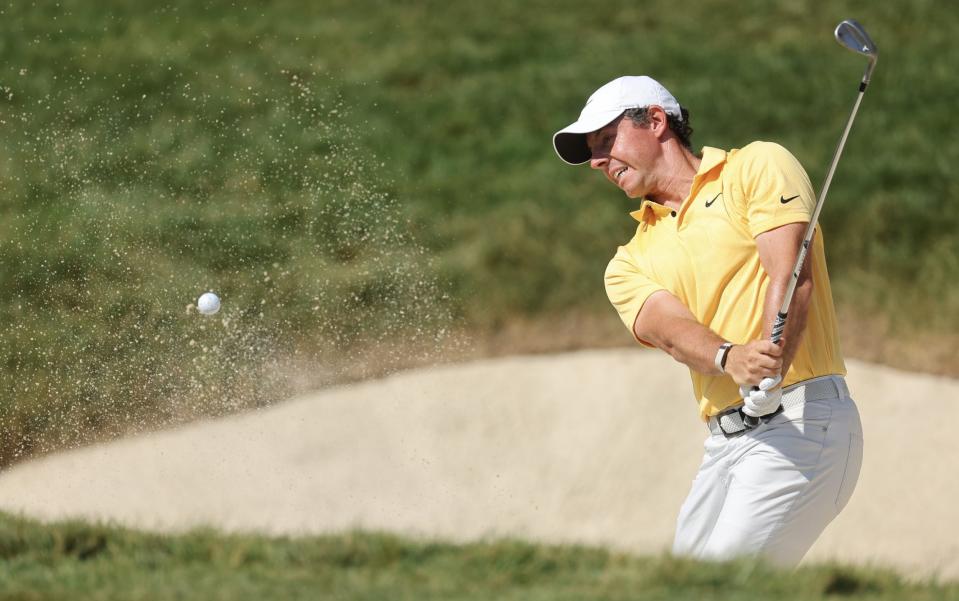Rory McIlroy’s latest headache – his wedge game has fallen apart

Everyone has an opinion on Rory McIlroy. Jack Nicklaus questioned his concentration levels before watching him cough up a 75 at the Memorial when the overnight leader on Sunday. And Phil Mickelson declared that the world No 3 was “worn out” and plainly be suited to the limited LIV schedule – but doubted any team would take him “because they’d have to deal with all his BS [bull----]”.
Yes, it is open season on the 34-year-old, which is probably appropriate with the US Open taking place at LA Country Club next week and the Open at Hoylake five weeks’ later. In short that means McIlroy has just seven weeks to stop his majorless run going double-digits and stretching into a 10th year.
McIlroy is in a race against the packed schedule and as he actually expressed himself as “feeling positive” after his tie for seventh in Ohio – a display which featured seven bogeys in the final round, including three in succession from the 12th – that shows the giant strides he needs to make before the sun falls on that Wirral links on July 23.
For McIlroy it is technical and he could do without all the surrounding noise. Certainly, in Mickelson’s case it would have been kinder, and definitely classier, to retain his own counsel, while even Nicklaus should have kept his concern out of the public domain. Nicklaus knew his comments to McIlroy, as he walked off Muirfield Village, would be picked up by the microphones and for that reason him saying “we need to have a chat sometime” verged on the brutal.
Nicklaus was there to shake each of the golfers’ hands and thank them for the patronage of the tournament he promotes. McIlroy might feel his host was being overly-generous.
No matter, McIlroy has already arrived in Toronto where he will try to make history this week by winning the Canadian Open for a third time in succession, a ‘threepeat’ unprecedented in the event’s 119-year existence. That should focus the mind, as should the clock loudly ticking in the background.
Except, McIlroy will contend that the problem is not between the ears, but between the shoulder blades. Granted he skipped an event straight after his woeful showing at The Masters and cited his “mental health” but by then he knew the gremlins had taken hold of his clubs and would not be letting go in the near future.

If you want to know if McIlroy is fighting his swing then look no further than his wedge play. On Sunday, four of his bogeys came from wedges. It was so familiar but appeared no less bizarre for someone of McIlroy’s ability. He continuously put himself in position off the tee, but then proceeded to make a hash of his approaches. As he works through his “two-way miss” this is the belligerent demon who will not be budged.
He is standing over his wedges fretting if he is going long or short and if the likelihood is for a soft draw or soft pull. That is what a pro means in the contradictory-sounding statement that he or she is “missing it in the right spots”. It is to do with control and exercising this control in certain parameters and that is where McIlroy is suffering. He has been through this before – as recently as 2021 when he appointed Pete Cowen to help with the exorcism – and understands that it will take time.
In layman’s terms, the two-way miss sees the golfer’s arms get trapped behind them and from there they either stay stuck [result: slice] or in an attempt to compensate with the hands, in the very last milli-seconds the golfer flips the club [result: hook]. As anything in golf, it invades the psyche as ruinously as it does the rhythm and, like a toxic weed, is infuriating to eliminate.
“If you’ve let your swing get to a certain place over the course of, say, six months, there’s no way that you’re going to work for two weeks and all of a sudden it’s going to be where you want it to be,” McIlroy said in Ohio. “I’m not saying it will take six months to get it to where I want to, but it will certainly take longer than a week or two.”
At last month’s USPGA, Cowen told Telegraph Sport that it could take McIlroy “a couple of months” to eradicate from his system. At Oak Hill, McIlroy finished tied-seventh on that occasion as well and although, of course, that was depicted as another failure, the fact that he said “I can’t remember a time when I felt so uncomfortable over the ball for four days” means that, in truth, it was anything but.
It is not the popular view, but McIlroy again overachieved at The Memorial considering his faltering motion and that is why eyeballs should not roll at his optimistic post-event assessment. “It’s a step in the right direction,” McIlroy said. “Obviously not the result I wanted but I feel a lot more positive about things today than I was two weeks ago at Oak Hill. It’s nice. I can get straight back on the horse again in Canada and try to take the learnings from this week.”

 Yahoo Sport
Yahoo Sport 





































